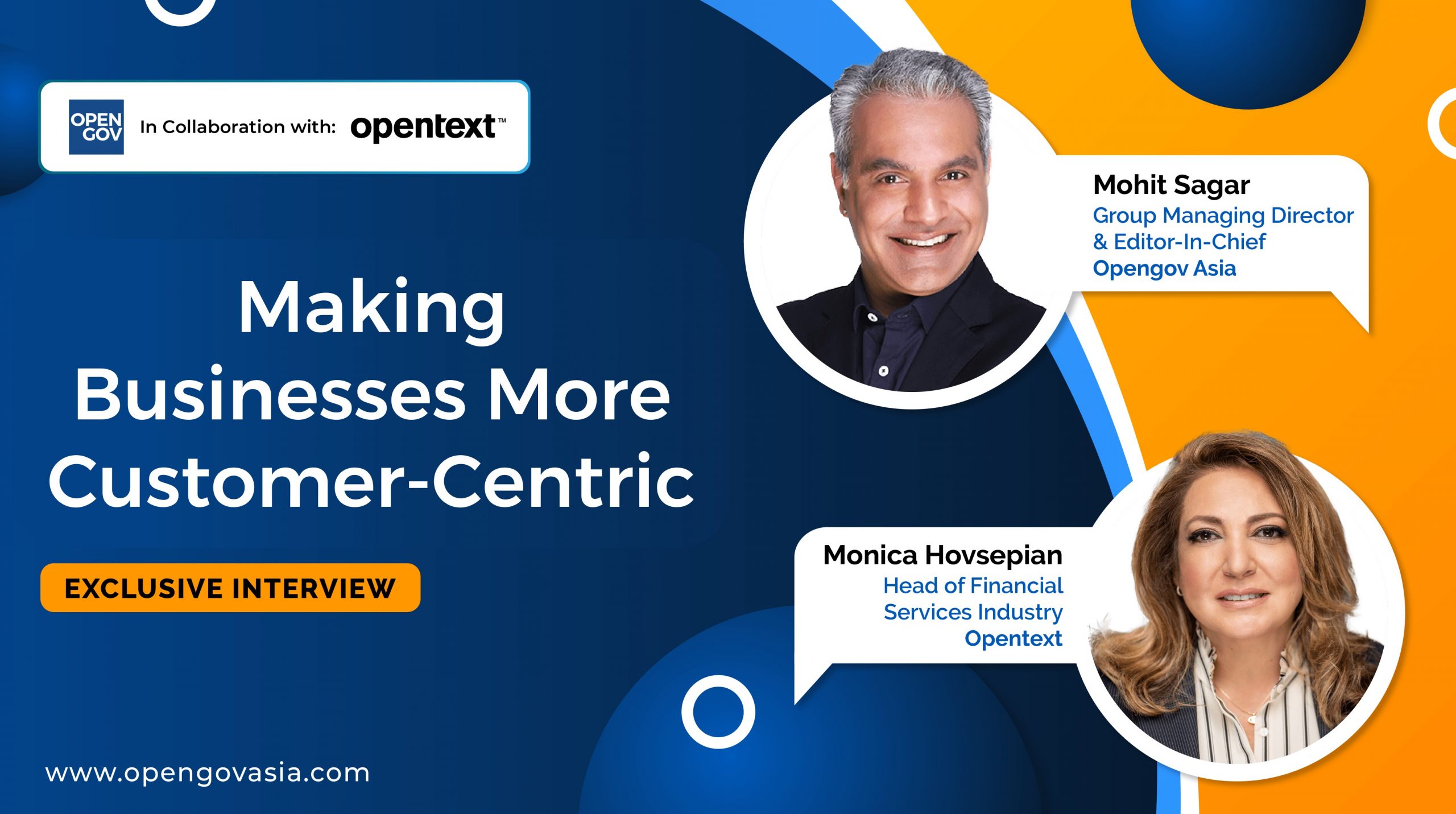
With the growing demand for digital public services during the COVID-19 pandemic, ‘customers’ expectations have escalated. Businesses must rethink and devise an effective strategy to provide their products and services through customer-centric digital offerings.
 OpenGov Asia had the opportunity to speak with Monica Hovsepian, Head of Financial Services Industry at OpenText, to gain her insights on how businesses live up to increasing customers’ expectations and deliver customer-centric services.
OpenGov Asia had the opportunity to speak with Monica Hovsepian, Head of Financial Services Industry at OpenText, to gain her insights on how businesses live up to increasing customers’ expectations and deliver customer-centric services.
In her role, Monica is responsible for the financial services industry strategy and marketing globally at OpenText across all business units. Monica has over 25 years of financial industry experience. She is a trusted subject matter expert in the Financial Services Industry, having worked with numerous large and international banks in North America, Europe, and Asia.
As an Information Management company, OpenText provides software and services that empower digital businesses of all sizes to become more intelligent, secure and connected.
Higher Expectations Require New approach
Undoubtedly, culture and paradigms have shifted; people do things dramatically differently and have higher expectations. Customers want services to be predictive instead of having to chase the services. The question is: what are the ‘industry’s requirements and how will businesses approach the higher customers’ expectations?
Monica starts by looking back at the moment when the pandemic erupted, and the governments around the world were announcing lockdowns or heavy movement restrictions. The old way of living life had changed forever at that instant and will likely never go fully back to what it was. People had to engage almost entirely digitally. Homes, kitchens, dining and living rooms became workspaces and schools, and a screen doubled as a whiteboard, office and grocery store.
In the past, many people did not use many applications such as video calls, but it has become mainstream now. People have also started engaging with certain brands and always expect seamless transactions. The constant digital engagement creates new vocabulary that had not existed or was not too common before. This is one of the manifestations of how digitalisation has created a massive culture change.
In this global realignment, Monica agrees that Singapore is an emerging market that is more digitally advanced than most countries, including many places in North America.
Monica emphasises that there is a digital gap in certain industries – there are the digital doers and the digital fakers. Some of the digital fakers dissipate and are not around anymore. However, the ones that are still in business are those who realise they need to get their business in gear. There is no more room for those digital fakers as today’s customers are demanding fast, intuitive, seamless and personalised high-quality services.
Customers learn about what is possible from other applications and engagement and compare the services that do not live up to those ideals. They are willing to pay more to companies that provide faster service, but as citizens, they are unwilling to pay for faster government services.
Customer Experience is Priority
Top companies can deliver seamless services because they have the money and resources. However, the public sector and other mid-size organisations have finite resources with finite team sizes, yet they have to innovate and become more creative. There is also a massive gap between North America and South-East Asia. Given the new challenges, how do organisations build their digital strategy?
Monica firmly believes the reason why top companies are doing great is that they put customers in the centre.
They build their strategy with that ideology and constantly tweak their plans. They consistently monitor and make changes to their front end. There might be minor changes, but they are continually updating it. They make the user interface and engagement easier and better and keep testing it – in the final assessment, It’s not only about the product but also about engagement.
On the other hand, in other industries, it is all about the products. So if the methodology is changed, things would move forward better. In the past, in financial services, it was also about the products. Nowadays, successful companies are focusing on the customers and putting them in the centre. However, while technology provides organisations with agility, they must ensure a customer-centric mind shift.
How OpenText Helps Customers to Create Seamless Experience
Creating a seamless experience comes with the challenge of integrating existing platforms as well as legacy systems and legacy tech. There is no one-size-fits-all solution, Monica warns, saying that no two customers are going to do things the same way when it comes to a transformational project. Every customer is on a different journey path and has different requirements.
OpenText strives by understanding where the customers are on their path, what their key objectives are and what challenges they face. OpenText helps customers to do discovery through which they determine and execute the transformation and modernization.
Customers create zettabytes of information and organisations want to be able to consume this information to serve the customers properly. As an information management company, OpenText has various methods to integrate existing platforms. They have several ways of consuming the information and ensuring that none is ever lost and archiving what needs to be to be retained.
Monica offers the analogy of two people with the same characteristics and traits but who are actually on the opposite end of the spectrum of individuals. Organisations would need a lot more data and information to be able to cater to people with similar characteristics but have opposite personalities, likes, and traits. Similar people, with varying tastes and preferences, are out there by the millions so organisations need to better understand customers and differentiate services accordingly.
When it comes to talent, Monica explains that there is a war for professionals. This is because, from a young age, people do not see working for governments or financial services as having interesting projects to be involved in.
Currently, a lot of government agencies and financial services are investing heavily in fascinating projects from Artificial Intelligence (AI) to cybersecurity. Moreover, increased digitalisation has given birth to a rise in cyberattacks across all industries. In the current situation, there is a paucity of talent in both aspects – creativity and security.
Case Study
One of ‘OpenText’s success stories is MSIG Asia – an international insurance company that has built omnichannel self-service capabilities and grown its business with ‘OpenText’s information management platform.
Like other insurance providers, MSIG Asia faced shifting challenges, often steeped in massive amounts of data and hyper-digital expectations from customers. The pandemic added complexity as a more distributed workforce strained to keep pace with highly regulated and collaborative processes as well as a growing necessity for digitisation and self-service, internally and externally.
Pandemic conditions aside, insurance professionals need accessible insights and customers need convenient tools. To this end, digital insurance policy documents provide information via eco-friendly alternatives to paper documents that simultaneously support MSIG ‘Asia’s biodiversity goals. The accessible information underpins increasing demand for self-service opportunities and meaningful online presence, both objectives of the insurance ‘provider’s digital transformation strategy.
To support its efforts on omnichannel customer acquisition and retention, MSIG Asia implemented an information management solution from OpenText. This included OpenText Extended ECM, OpenText AppWorks and OpenText Exstream. Together these solutions help form a ‘single source of ‘truth’ and communication platform for MSIG.
“This customer-centric integration will help maximise operational efficiencies across different lines of businesses and locations, which in turn helps lower expenses and strengthens the business infrastructure. Quite essentially, this has empowered our business operations with a single system that can better enable growth and support the innovations and adaptability required to meet the fast-changing business demands for the long haul”,” said Joseph Yew, CIO, MSIG Asia.
Another OpenText customer is the Ministry of Finance Singapore. Vital, the Singapore Government’s centre for shared services, appointed OpenText – through a public tender process – to digitise its back-office corporate services, comprising over two million records per year for over 100 Government agencies.
In its effort to aggregate common administrative services and benefit from economies of scale, the Electronic Document and Knowledge Management System (eDKMS) will enable Vital to integrate daily HR, payroll and finance workflows for higher productivity, as well as foster greater knowledge management and a social collaboration platform within Vital. The system reduces paperwork and manages the flow of information from capture through to archiving and disposal.
As a part of Singapore’s drive to build a Smart Nation and a digital government, Vital is taking its steps to reduce paper-intensive workflows in back-office operations, improve records and case management, and enhance business information analysis and decision-making.
OpenText Content Suite enabled Vital to remain compliant with government-mandated document management policies, improved records and case management accountability and enhance business information analysis and decision-making. Using OpenText, the eDKMS provided Vital with the tools to reduce paper-intensive workflows and deliver timely information sharing for improved collaboration.
The Future of Customer-Centric Operations
Monica states that human beings are creatures of habit. People have gotten used to working from home and have shown their employers that they can be trusted. The fact is people ended up working much longer hours as a result it was a benefit to the employers as revenue actually went up.
From her own experience, Monica has observed that the trust question about working from home has gone away. On the other hand, organisations need to ensure employees want to stay otherwise they will leave. In fact, the Great Resignation is happening right now. As the pandemic has been a huge stress for people, employees may well leave if they are mandated to work fully at the office again.
Employees are looking for a better employee experience and deeper engagement. Organisations cannot have a good customer experience if they do not deliver a good employee experience as both go hand in hand. Organisations need to deliver the same kind of customer experiences to their employees so they can deliver the organisations’ vision and mission. Organisations must provide the tools for employees to be able to serve customers and give employees the same digital experience as well.
“We should be digitising the humans and humanising the digital. It has to go hand in hand now,” Monica emphasises.
In Monica’s opinion, much investment will go towards platforms in the future. Organisations are looking for a single platform. Organisations realised the issues they suffered in maintaining all the investments they had made in niche technology and hence they are now considering moving to single platforms. Simplification of the architecture in a single platform is the decision to move forwards.
Cloud technology is being embraced wholeheartedly as well. A lot of investment was done in cloud technology when the pandemic initially started and continues.
However, Monica reiterates the importance of putting customers at the centre as they will leave any businesses that do not live up to their expectations quickly. Customers across generations are looking for organisations that can provide them with very specific wants, needs and beliefs.
Why Partner with OpenText
OpenText is an Information Company that enables organisations to gain insight through market-leading information management solutions, on-premises or in the cloud. OpenText believes that information and knowledge make business and people better. Its mission is to deliver compelling innovation that provides the customers with a competitive advantage. Its strategy to deliver information management in the cloud at scale to power digital businesses of all sizes
Manage information end-to-end:
- Master Modern Work: Master collaboration while reducing security and governance risk by enriching business processes with content, insights and automation.
- Digitise the Supply Chain: Integrate systems, people and things, enabling businesses to seamlessly exchange information with their trading partners to accelerate productivity.
- Power Modern Experiences: Power customer interactions with engaging experiences across the entire customer journey, from acquisition to retention.
- Be Cyber Resilient: Protect and secure data and mitigate risk with best-in-class technologies and personnel to grow securely.
- Build the API Economy: Build, extend, and customise applications faster and smarter using a collection of Information Management API services in the cloud.
Monica feels that the beauty of OpenText is the fact that it provides everything for the entire lifecycle of customers. OpenText can help customers with all they need, including marketing, services, onboarding customers, cybersecurity, risks and, compliance. We are one organization, offering integrated products and services, on the cloud or on-premise, we are committed to our customer’s success. OpenText is the Information Management company and the future is ensuring a single-pane view of the customer’s and the business’ information.
OpenText wants to partner with customers so they can grow together. She is firmly convinced that customers can truly flourish with OpenText.
















